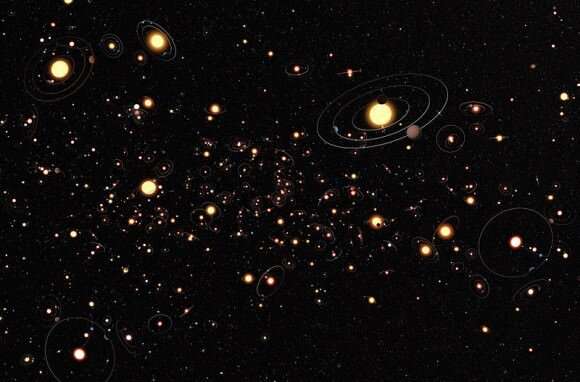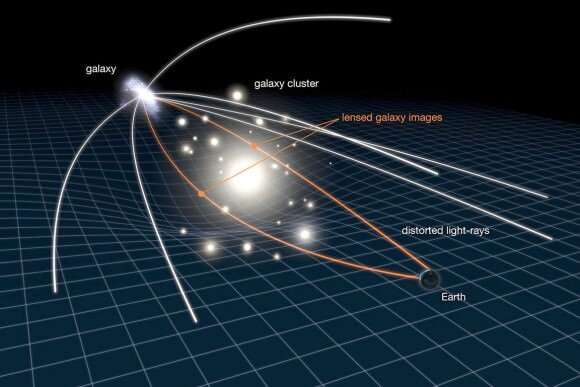Based on the theory that ETIs exist and have already established a communications network in our galaxy, the team identified Wolf 359 as the best place to look for possible interstellar communications from an alien probe.
The study, which is being reviewed for publication in the Monthly Notices of the Royal Astronomical Society, was conducted by Michaël Gillon and Artem Burdanov. Gillion is a professor of astrophysics at the University of Liege, a Senior Research Associate with the Belgian National Fund for Scientific Research (NSRF), and a member of NASA's Nexus for Exoplanet System Science (NExSS), and Burdanov is a Postdoctoral Associate with the Department of Earth, Atmosphere, and Planetary Sciences (EAPS) at MIT.
Additional insight and support came from Prof. Jason Wright, a Penn State Center for Exoplanets and Habitable Worlds member and director of the Penn State Extraterrestrial Intelligence Center (PSETI). Like many who have proposed resolutions to the Fermi Paradox, Gillon and Burdanov began their study with the assumption that extraterrestrial life has had a significant head start on humanity. From a cosmological standpoint, this is a pretty safe assumption.
According to accepted models, the Milky Way galaxy formed roughly 13.51 billion years ago, followed by the first planets 500 million years later. Our solar system is a relative newcomer, having formed 4.5 billion years ago, and humanity has only existed for the last 200,000 years. It stands to reason that intelligent species have already emerged and have had the necessary time to colonize the Milky Way.
In their new study, the team built upon a 2014 study by Gillon that showed how an ETI could have filled our galaxy with self-replicating probes (von Neumann machines). This idea is similar in theme to the Berserker hypothesis, but with the caveat that these probes were built for peaceful exploration. These probes, he argued, could form a galaxy-spanning communication network using stars as gravitational lenses to maximize their communication efficiency.
As Gillon told Universe Today via email, this activity would constitute a viable technosignature that could be detected:
"In this hypothesis, every star of the Milky Way should host such probes, including the sun. This hypothesis tells us where to look for these probes: at the "solar gravitational line" (SGL) of the nearest stars, i.e., at the opposite coordinates to the nearest stars. I explored this hypothesis further by considering different possible methods to detect these probes.
"The problem is that the SGL is very far from the sun, as it starts at 550 astronomical units, so any communication device out there would be extremely difficult to detect. This was the main conclusion of my 2014 work: searching for these probes is worth a try, but we would need to be very lucky to detect anything."
In this study, Gillon, Burdanov, and Wright focused on how humanity might detect interstellar messages coming from these probes—which they refer to as Focal Interstellar Communication Devices (FICDs). For this, they identified Wolf 359—an M-type (red dwarf) star located with two possible exoplanets—as the best target for such a search. At a distance of about 7.9 light-years, Wolf 359 is the third closest star system, Alpha Centauri and Barnard's Star—excluding Luhman 16 (a Brown Dwarf 6.5 light-years away).
According to research published in 2019, Wolf 359 is suspected to be very similar in structure to Proxima b, the closest star system to Earth (4.24 light-years away). Both systems consist of a low-mass red dwarf star with one closely orbiting planet (up to a few times as massive as Earth) and a more distant larger planet (possibly a gas giant). However, unlike Proxima b and c, Wolf 359's system of planets has not yet been confirmed.
After releasing his 2014 study, Gillon noticed that this Wolf 359 happens to lie in the ecliptic, the orbital plane of Earth. In short, Wolf 359 is viewed edge-on from Earth (and vice versa), which means that observers in either system would be able to see exoplanets making transits in the other. This arrangement, says Gillon, would also allow FICDs to send interstellar messages with regular frequency:

"Due to this particular position, the Earth should lie once per year in the communication beam of at the putative solar probe emitting towards Wolf 359. I made some computations that made me conclude that if the probe emits to Wolf 359 in the optical range when the Earth is in its beam, we should be able to detect its emission even with a modest-size telescope."
To test this hypothesis, Gillon consulted data from the TRAnsiting Planets and PlanetesImals Small Telescope—South (TRAPPIST-South) and the Search for habitable Planets EClipsing ULtra-cOOl Stars-South (SPECULOUS-South). These telescopes are located at the European Southern Observatory's (ESO) La Silla and Paranal Observatory (respectively) in northern Chile. Using these instruments, Gillion observed Wolf 359's SGL for signs of communication emissions at the corresponding time of year.
Burdanov explored the data further for signs of a slow-moving object whose motion conformed to what one would expect from such a probe. Unfortunately, neither the telescope data nor Burdanov's targeted search indicated FICDs in Wolf 359. "Interpreting this null result is difficult, as tons of hypotheses could explain it," said Gillon. However, he also explained how these results could create new opportunities for future SETI surveys:
"While considering this null result, I realized that the emitting probes could be "off-axis" and much closer to Earth than the SGL, and that they could maybe be detected directly in imagery. The possibility of off-axis emitting probes opens a new avenue for the search for alien devices in our solar system. We intend to explore it further, observing the antisolar coordinates of the 10 to 20 nearest stars with our telescopes. We'll also observe the ones of 'our' system TRAPPIST-1, just for fun."
Surveys for extraterrestrial probes will also benefit from the many next-generation instruments available in the coming years. These include the Vera C. Rubin Observatory that will survey our galaxy, measure the expansion of the cosmos, and map out the objects of the solar system—including interstellar objects (like "Oumuamua). The James Webb and Nancy Grace Roman Space Telescopes will be able to visualize objects with far greater sensitivity and precision.
There's also the Extremely Large Telescope (ELT), the Giant Magellan Telescope (GMT), and other ground-based observatories that will become operational in the coming years. These observatories will study objects that are too faint for existing telescopes using a technique known as Direct Imaging. When these instruments begin gathering light in the next few years, adding possible FICDs to the list of potential targets could prove beneficial.



